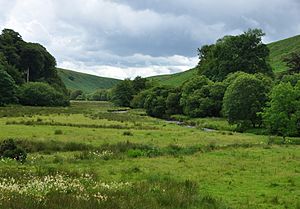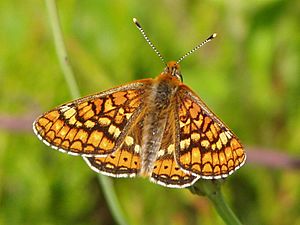Barle Valley facts for kids
| Site of Special Scientific Interest | |

Barle Valley at Simonsbath
|
|
| Area of Search | Somerset and Devon |
|---|---|
| Coordinates | 51°09′56″N 3°49′40″W / 51.16565°N 3.82778°W |
| Interest | Biological |
| Area | 1,539.2 acres (6.229 km2; 2.4050 sq mi) |
| Notification | 1988 |
The Barle Valley is a special natural area, about 1540 acres (or 623 hectares) big. It's called a Site of Special Scientific Interest (SSSI) because it has important plants, animals, and habitats.
It's located inside Exmoor National Park, stretching across parts of Devon and Somerset. The beautiful River Barle flows right through it. This area was officially recognized as special in 1988 under a law called the Wildlife and Countryside Act. Part of the valley includes the Mounsey Wood Nature Reserve, managed by the Somerset Wildlife Trust. Another part, Knaplock and North Barton SSSI, has been special since 1954.
Amazing Plantlife
The Barle Valley has steep hillsides made of sandstone, with soil that's a bit sour (acidic). These hillsides are home to very old forests, mainly filled with Sessile Oak trees. These woodlands grow between 500 feet (150 meters) and 1000 feet (300 meters) up the valley sides.
Scientists have found over 85 different types of plants with tubes for water (called vascular plants) here. Thirty-one of these are 'ancient woodland indicators,' meaning they show the forest has been around for a very long time.
You can also find wet, boggy areas (called mires), open heathland, and grassy spots with acidic soil. These meadows are full of different kinds of life. They are one of the few places on Exmoor where you can find the great burnet plant. The mires get their water from springs that flow from the bottom of the sandstone slopes. They are mostly covered in moss because the water doesn't have many nutrients.
In the woodland areas, there are lots of lichens. Over 165 groups of lichens that grow on trees (called epiphytic lichens) have been found. Many of these are rare species. Because of all the ancient woodland indicator plants, the Barle Valley has a very high 'index of ecological continuity.' This means its natural habitats have been stable for a long time.
Wonderful Birds
The valley is a great place for many different birds that nest in woodlands. You can find especially large numbers of redstarts, wood warblers, and pied flycatchers here. These birds are all 'summer migrants,' meaning they fly here for the summer to breed and then leave for warmer places in winter.
The River Barle itself is an important home for birds like the kingfisher, dipper, and grey wagtail. In the scrub and heathland areas, you might spot stonechats and whinchats nesting.
Other Cool Animals
Over twenty different types of butterflies have been seen in the valley. This includes the marsh fritillary butterfly, which is rare in the country, and the high brown fritillary, which is considered vulnerable.
You might also see roe deer and red deer grazing in the pastures. Otters have been spotted along the River Barle too. There's even a group of dormice living in at least one of the hazel coppices (areas where trees are cut back regularly to encourage new growth).



